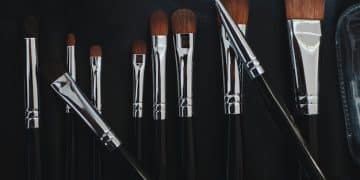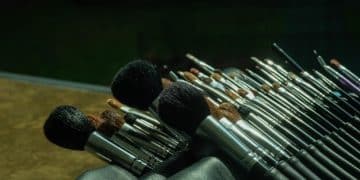Master Men’s Contouring: Defined Jawline Makeup Tutorial
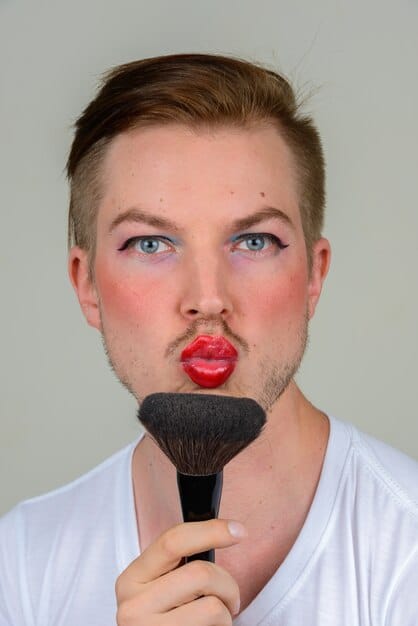
Achieving a defined jawline through men’s makeup contouring involves strategic product placement and blending techniques to sculpt facial features, enhancing natural bone structure for a more chiseled appearance. This tutorial guides men through the process of selecting the right products and applying them effectively to achieve a distinguished look.
In the evolving landscape of men’s grooming, the art of contouring has emerged as a nuanced technique for enhancing facial features, moving beyond traditional skincare to embrace cosmetic refinement. This guide will walk you through how to contour your face like a pro: a men’s makeup tutorial for a defined jawline, detailing the steps and products necessary to achieve a subtly sculpted and more defined appearance.
Understanding the Basics of Men’s Contouring
Contouring for men isn’t about dramatic transformation but rather about subtle enhancement. It’s a strategic play of light and shadow designed to define bone structure, particularly the jawline and cheekbones, creating an illusion of depth and sculpting. This technique, when done correctly, should be imperceptible, making it appear as though you’ve simply been blessed with naturally sharp features.
What is Contouring and Why is it for Men?
Contouring involves using darker shades to create shadows and lighter shades (highlighting) to bring areas forward. For men, this translates to gently enhancing features that are often associated with masculine attractiveness: a strong jawline, pronounced cheekbones, and a sculpted nose. It’s about elevating your natural appearance, not masking it, offering a refined edge to your overall look.
- Enhanced Definition: Sharpens the look of your jawline and cheekbones.
- Subtle Refinement: Creates an effortlessly well-groomed appearance.
- Confidence Boost: Feeling good about your appearance can significantly impact self-esteem.
The perception of makeup for men has shifted dramatically. What was once considered taboo is now increasingly accepted as a tool for personal grooming and expression. Men are embracing makeup for various reasons, from camouflaging imperfections to enhancing desired features, all contributing to a more polished and confident self-presentation. The key is to approach it with a focus on natural, undetectable results.
Choosing the Right Contouring Products
The success of your contouring efforts hinges on selecting the right products. For men, cream or stick formulas are often preferred over powders due to their ease of blending and more natural finish, which melts seamlessly into the skin rather than sitting on top of it. Shade selection is paramount: the contour shade should be cool-toned and about two shades darker than your natural skin tone to mimic natural shadows, avoiding anything too warm or orange.
Selecting Your Contour Shade and Formula
When choosing a contour shade, think cool undertones – grays, browns, and taupes. Avoid anything with a red or orange tint, as these will look unnatural and muddy. A good test is to swatch a small amount on your jawline in natural light. It should look like a shadow, not a streak of color. As for formula, creams and sticks are often more forgiving for beginners and provide a more natural, skin-like finish.
- Cream Sticks: Easy to apply directly, great for precise lines.
- Cream Palettes: Offer a range of shades for custom blending, good for versatility.
- Liquid Contours: Provide a very natural, dewy finish, but can be trickier to blend.
Beyond the contour itself, you’ll need a good foundation or tinted moisturizer that matches your skin tone perfectly for an even base. A translucent setting powder can also be useful to lock everything in place, especially if you have oily skin or want maximum longevity. For subtle highlighting, a matte setting powder that is slightly lighter than your skin tone around the eyes area can also create an effect of highlighting effectively.
Essential Tools for Application
While the right products are crucial, the proper tools ensure a flawless application. For contouring, brushes and sponges are your best allies. A dense, angled brush is ideal for applying the product precisely along the jawline and cheekbones, while a beauty blender or damp sponge is perfect for seamlessly blending the product into your skin, eliminating harsh lines.
Brushes vs. Sponges: Which to Use?
Each tool has its advantages. Brushes, particularly those with synthetic fibers, offer precision and can deposit more product, making them excellent for initial application. Sponges, on the other hand, are masters of blending. A damp beauty sponge can pick up excess product and press the contour seamlessly into the skin, achieving that coveted “no makeup” makeup look.
- Angled Contour Brush: For precise application along the jawline and cheekbones.
- Small Detailing Brush: Useful for nose contouring or smaller areas.
- Damp Beauty Sponge: Essential for blending out harsh lines and achieving a natural finish.
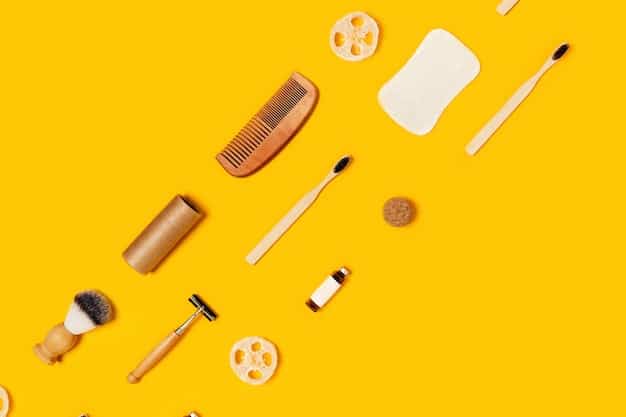
Having a clean set of tools is also vital for hygiene and product performance. Regularly washing your brushes and sponges prevents product buildup and keeps them performing at their best. Consider also some small, precise brushes if you plan to contour smaller areas like the nose, as larger brushes might be too unwieldy for such delicate work.
Step-by-Step Jawline Contouring Tutorial
Mastering the art of jawline contouring is all about precision and blending. This step-by-step guide walks you through the process, ensuring a defined yet natural result. Remember, practice makes perfect, so don’t be discouraged if your first attempts aren’t flawless.
Preparing Your Skin for Contouring
Start with a clean, moisturized face. Apply your usual foundation or tinted moisturizer evenly to create a smooth canvas. This step is crucial as it creates a uniform base for your contour product to blend into. Ensure your base is set before moving on to contouring, especially if you’re using cream products.
- Cleanse: Wash your face to remove dirt and oil.
- Moisturize: Hydrate your skin for a smooth application.
- Base Makeup: Apply foundation or tinted moisturizer for an even tone.
Applying Contour to Your Jawline
Identify your jawline: from just below your earlobe, trace a line down towards the tip of your chin. Apply your contour product directly onto this line. The key is to apply it directly onto the bone, not below it, to create the illusion of a shadow. Use short, light strokes, building up the intensity slowly.
Blending for a Natural Finish
This is arguably the most critical step. Using a damp beauty sponge or a dense blending brush, blend the contour product downwards and slightly into your neck. The goal is to diffuse any harsh lines, making the contour look like a natural shadow. Blend until the product disappears into your skin, leaving no visible edges. Check your work in different lighting conditions, including natural light, to ensure seamless blending.
Enhancing Other Facial Features
While a defined jawline might be your primary goal, contouring can also subtly enhance other facial features, such as your cheekbones and nose, for an overall more sculpted appearance. The same principles of light and shadow apply, focusing on creating natural-looking definition.
Sculpting Your Cheekbones
To define your cheekbones, suck in your cheeks to find the hollows just beneath them. Apply a small amount of contour product in a diagonal line from your ear towards the corner of your mouth, stopping about two fingers’ width from your mouth. Blend upwards and outwards, ensuring the line seamlessly blends into your temple area. This creates the illusion of higher, more defined cheekbones.
- Identify Hollows: Locate the natural shadows beneath your cheekbones.
- Apply Diagonally: From ear towards mouth, stopping short of the mouth.
- Blend Upwards: Integrate the contour into your temples for a natural look.
Subtle Nose Contouring
Nose contouring is about creating the illusion of a straighter or narrower bridge. Using a small, precise brush, draw two thin lines of contour product down either side of your nose, starting from the inner corner of your eyebrows and extending straight down to the tip. Blend these lines gently outwards towards the center of your nose, keeping the darkest part on the sides of the bridge for a slimming effect. Avoid blending too far out, which can widen your nose.
Finishing Touches and Maintenance
Once you’ve achieved your desired contoured look, a few finishing touches can ensure longevity and a polished appearance. Setting your makeup, even just the contoured areas, can significantly extend its wear time and prevent smudging throughout the day. Regularly cleaning your tools also plays a crucial role in maintaining your hygiene and the effectiveness of your makeup application.
Setting Your Contour
To set your contour, lightly dust a translucent setting powder over the contoured areas. This step helps to absorb excess oil, lock the product in place, and prevent it from fading or creasing. If you prefer a completely matte finish, you can use a matte setting spray after powder application.
- Translucent Powder: Lightly dust over contoured areas to set.
- Setting Spray: A fine mist can prolong wear and meld products together.
Tips for Longevity and Removal
For all-day wear, consider a setting spray as a final step. This helps fuse all the products together and creates a protective barrier. At the end of the day, always remove your makeup thoroughly. Use a gentle cleanser or makeup remover to ensure no product is left on your skin, which can lead to breakouts or irritation. A double cleanse can be beneficial, especially if you’ve applied multiple layers of product.
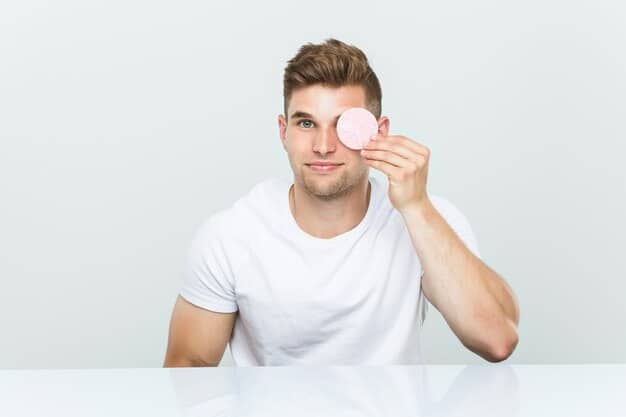
Regular maintenance of your tools, as mentioned before, should be part of your routine. Clean brushes and sponges not only apply product better but also prevent bacterial buildup, which is essential for healthy skin. Store your products in a cool, dry place to maintain their integrity and extend their shelf life.
Common Mistakes to Avoid
Even with the best intentions, it’s easy to fall into common pitfalls when contouring. Understanding these mistakes and how to avoid them can save you from an unnatural or overwhelming makeup look. The goal is always to enhance, not to create a mask. Paying attention to detail and practicing moderation are key.
Over-Contouring and Harsh Lines
One of the most frequent mistakes is applying too much product or not blending thoroughly enough, resulting in harsh, visible lines. Contouring should mimic shadows, which are naturally soft and diffused. Start with a tiny amount of product and build up gradually. Blend, blend, blend until you can’t tell where the product begins or ends.
- Start Small: Apply a minimal amount of product initially.
- Blend Diligently: Ensure no harsh lines are visible.
- Layer Gradually: Build intensity slowly rather than applying too much at once.
Using the Wrong Shade or Formula
As discussed, the shade and formula matter significantly. A contour shade that is too warm or orange will look unnatural, while a formula that’s too heavy can settle into fine lines or look cakey. Always test shades in natural light and opt for formulas that complement your skin type and desired finish. For most men aiming for subtle enhancement, cool-toned creams or sticks are the safest bet for natural results.
Another mistake is attempting to contour with just a bronzer. While bronzers add warmth and glow, they typically have warm undertones and shimmer, which are not suitable for creating natural shadows. Contouring is about sculpting with cool tones, while bronzing is about adding a sun-kissed look. They serve different purposes, though they can be used together, with contour applied first to define, and then bronzer added for warmth.
| Key Point | Brief Description |
|---|---|
| 🎨 Product Choice | Opt for cool-toned cream/stick formulas, 2 shades darker than skin, avoiding orange tints. |
| 🛠️ Essential Tools | Use angled brushes for precise application and damp sponges for seamless blending. |
| 📏 Jawline Technique | Apply contour directly on the jawbone from earlobe towards the chin, blend downwards. |
| ⚠️ Avoid Mistakes | Don’t over-contour or leave harsh lines; blend thoroughly for a natural, subtle effect. |
Frequently Asked Questions About Men’s Contouring
Yes, absolutely. Societal norms regarding men’s grooming and self-care are rapidly evolving. The perception of makeup for men has shifted from being taboo to being openly accepted as a tool for personal enhancement and confidence, reflecting a broader trend towards inclusive beauty standards.
The frequency depends entirely on personal preference and your lifestyle. Some men might choose to contour daily for work or events, while others reserve it for special occasions. Since natural results are key, daily contouring can be subtle enough for everyday wear if desired.
While contouring can create the illusion of a more defined jawline, it’s not a permanent solution for a double chin. It can effectively minimize its appearance by casting a subtle shadow in the right areas, making the jawline appear sharper. For a more significant effect, combine with proper posture.
Contour products are designed to create shadows and define features, typically having cool, ash-toned undertones. Bronzers, on the other hand, add warmth and a sun-kissed glow to the skin, usually with warm, reddish or golden undertones. They serve different purposes and achieve distinct effects.
Select a contour shade that is two shades darker than your natural skin tone and has a cool undertone (gray, taupe-brown). Avoid shades with orange or red hues, which will look unnatural. Swatch the product on your jawline in natural light to ensure it blends seamlessly like a shadow.
Conclusion
Embracing contouring is a natural evolution in men’s grooming, offering a sophisticated way to enhance facial features with subtlety and precision. This tutorial on how to contour your face like a pro: a men’s makeup tutorial for a defined jawline provides a comprehensive guide for achieving a more sculpted and confident appearance. By selecting the right products, utilizing appropriate tools, and mastering blending techniques, men can achieve a refined look that complements their natural bone structure without appearing overly made up. The journey into men’s makeup, particularly contouring, is less about transforming and more about perfecting, allowing individuals to present their best selves with an elevated sense of self-assurance and style.

